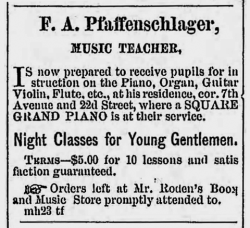Frank Pfaffenschlaeger
Frank A. Pfaffenschläger or Pfaffenschlaeger, also recorded as Pfoffschlager (born 1818 or 1822 in Switzerland; died March 14, 1882) was a Civil War veteran who settled in Birmingham as a music teacher.
Pfaffenschlaeger claimed to have emigrated after suffering a leg wound in the Revolutions of 1848, and to have organized a troupe of "bell ringers" that toured the country, as far as San Francisco. He enlisted in the Confederate army in 1861 in New Madrid, Missouri, and made a name for himself as a talented bugler. His friend William "Zou" Hartmann of the 38th Alabama Infantry arranged for his transfer to that regiment from the Tennessee Light Artillery so that he could become part of the regimental band. He was described then by a fellow soldier as, "a small man, short neck, round shoulders, crooked legs, thin face, hooked nose, sharp eyes that had a look of dissipation about them, and a thin, brown moustache that hardly covered his thin upper lip."
Pfaffenschlaeger became chief musician, having the opportunity to demonstrate his skills not only on the bugle, but also with the piano, violin, fife and guitar. He became known for his good nature and kindness. He was able to transcribe tunes that he heard in his travels, and also excelled as an artist, with officers pooling money to buy his ornamented drawing of the regimental headquarters to give as a gift to their Colonel, Charles T. Ketchum.
Pfaffenschlaeger served with distinction through the remainder of the 38th's campaign. He carried a heavy hunting rifle with a large bore and a specially-made bullet mold. He fought at Chickamauga, Lookout Mountain, Missionary Ridge, Rocky Face Mountain and later the Battle of Spanish Fort, where he was one of 80 who survived and accompanied General Richard Taylor to their surrender at Citronelle.
In 1878 Pfaffenschlaeger married Nancy Ann Jones Stone, a widow with three teenage daughters. In 1880 they resided in Pickensville, but by 1881 had moved to Birmingham where he advertised instruction in piano, organ, guitar, violin, flute and other instruments from his home on the corner of 7th Avenue North and 22nd Street.
In 1882, while talking with friends, Pfaffenschlaeger suddenly produced a Derringer pistol and shot himself through the right temple. After his death, a friend told the Mobile Daily Register that Pfaffenschlaeger was actually an Austrian noble, Lord Seeau, who had opposed Emperor Franz Joseph and narrowly escaped the country with his life after the revolution of 1848, and that his son, Franciscus Adolphus von Seeau, had inherited his title and lands. This identification has been characterized as doubtful by Austrian authorities on the Seeau nobility.
Pfaffenschlaeger is buried under a large obelisk at Oak Hill Cemetery, which he shares with his widow, Nancy, along with her first husband George Washington Stone, and numerous descendants.
References
- La Rochejaquelein (March 29, 1882) "'Frank': A Soldier's Story of a Soldier." Mobile Register, reprinted March 30, 1882 in the Birmingham Iron Age, p. 1
- Green, Art (n. d.) "Frank Pfaffenschlaeger, Forgotten CSA Soldier - An Unusual Man with an Unusual Name" reprint of article published in the Civil War Courier and in Green's Southerners at War - the 38th Alabama Infantry Volunteers.
External links
- Frank. A. Pfaffenschaelager [sic] at Findagrave.com
